
The Formicinae are a subfamily within the Formicidae containing ants of moderate evolutionary development.

Formica is a genus of ants of the family Formicidae, including species commonly known as wood ants, mound ants, thatching ants, and field ants. Formica is the type genus of the Formicidae, and of the subfamily Formicinae. The type species of genus Formica is the European red wood ant Formica rufa. Ants of this genus tend to be between 4 and 8 mm long. Ants belonging to the Formica genus possess a single knob or bump located between their thorax and abdomen. These ants primarily feed on honeydew, a sugary liquid produced by aphids. Formica ants appear to take on a shepherding role with smaller aphids, relocating them to different parts of plants to ensure a continuous food source for the aphids. By doing so, the ants can establish a relatively sustainable honeydew supply for both themselves and their colony.
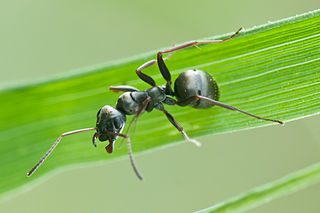
Formica fusca is a black-colored ant commonly found throughout Europe as well as parts of southern Asia and Africa. It has the common names silky ant or dusky ant. The range within the palaearctic region extends from Portugal in the west to Japan in the east and from Italy in the south to Fennoscandia in the north. Populations from North America have been split off as a separate species, Formica subaenescens. F. fusca nests are usually found in rotten tree stumps or under stones in clearcut areas and along woodland borders and hedgerows.

Formica pratensis, the black-backed meadow ant, is a species of European red wood ant in the family Formicidae.
Colobopsis anderseni, synonym Camponotus anderseni, is a species of mangrove ant found in northern Australia.
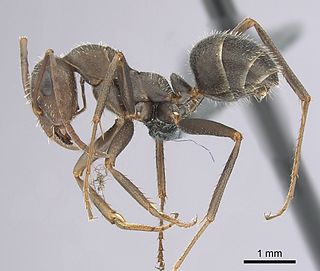
Iberoformica is a small genus of ants in the subfamily Formicinae.
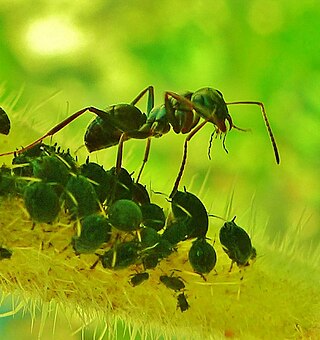
Formica glacialis is a species of ant in the family Formicidae.
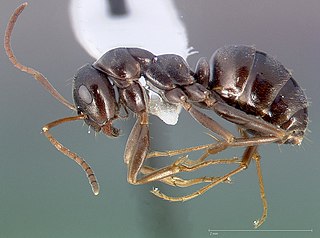
Formica microphthalma is a species of ant in the family Formicidae.

Myrmelachistini is a tribe of ants in the family Formicidae. There are at least 2 genera and 50 described species in Myrmelachistini.
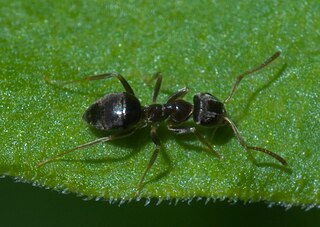
Lasiini is a tribe of ants in the family Formicidae. There are about 10 genera and more than 450 described species in Lasiini.

Brachymyrmex patagonicus is a species of ant in the family Formicidae. B. patagonicus, commonly known as the dark rover ant, is native to Argentina and Paraguay. They were first reported in St. Tammany Parish, Louisiana in 1978 from a single colony collected in 1976. It is believed that the species was introduced through New Orleans, which is a common entry point for many tropical species, but other locations such as Mobile, Alabama, or Pensacola, Florida, are also likely. For many years B. patagonicus, B. musculus, and B. obscurior were misidentified as being separate species but after a comparison of specimens from the Louisiana State University Arthropod Collection (LSUC), it was found that all three were the same species. B. patagonicus is considered a nuisance pest due to their tendency to infest man made structures but they have received a lack of attention because they do not bite, sting, or carry disease.

Camponotus castaneus, the red hazelnut carpenter ant, is a species of ant in the family Formicidae. It is a primarily orangish-red ant in the family Camponotus. Its workers are usually around 8-10 mm, and queens around 18-20 mm. As with most Camponotus species, camponotus castaneus has majors and super-majors, usually appearing in the second or third year of the colony's founding, majors are usually 10-14 mm, with super majors being around 13-17 mm. Camponotus castaneus has a generalist diet, feeding on insects and carbohydrates such as honeydew, which is easily accessible. This ant is not a pest therefore you should not use pesticides against them. The ant has a smooth thorax and abdomen, with 1 node separating them.

Formica ravida is a species of ant in the family Formicidae.

Camponotus chromaiodes, known generally as, the ferruginous carpenter ant or red carpenter ant, is a species of ant in the family Formicidae. Acetobacteraceae are found in the guts of workers in this species.

Formica obscuriventris is a species of ant in the family Formicidae.

Formica moki is a species of ant in the family Formicidae.

Formica archboldi is a species of ant in the family Formicidae. They are known for their abnormal behavior, which includes the collection and storage of Odontomachus (trap-jaw) ant skulls.

Colobopsis is a genus of ant in the subfamily Formicinae. This genus was first described in 1861 by Mayr and contains 95 species. The type species is Colobopsis truncata.

















